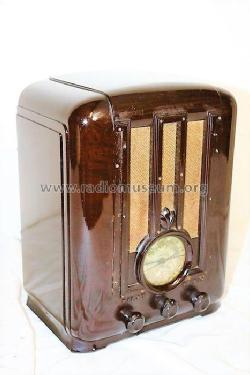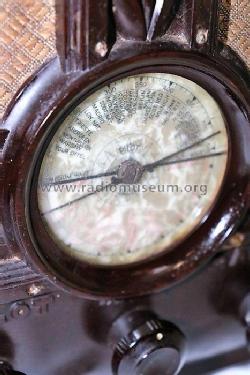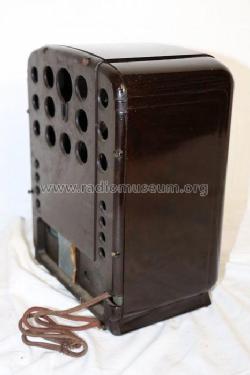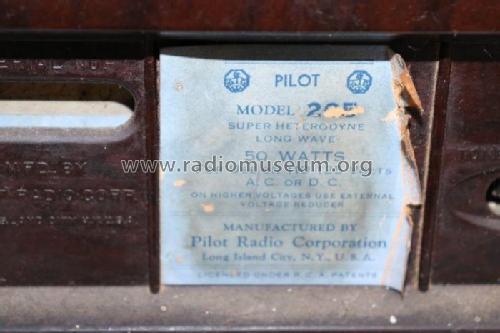- Produttore / Marca
- Pilot Electric Mfg. Co. (Radio Corp.); Brooklyn (NY)
- Anno
- 1936
- Categoria
- Radio (o sintonizzatore del dopoguerra WW2)
- Radiomuseum.org ID
- 51777
-
- alternative name: Pilot Radio & Television || Pilot Radio and Tube || Pilot Radio Corporation
Clicca sulla miniatura dello schema per richiederlo come documento gratuito.
- Numero di tubi
- 5
- Principio generale
- Supereterodina (in generale); ZF/IF 456 kHz
- N. di circuiti accordati
- 6 Circuiti Mod. Amp. (AM)
- Gamme d'onda
- Onde medie (OM) e onde lunghe (OL).
- Tensioni di funzionamento
- Alimentazione universale (doppia: CC/CA) / 115 / 220 / 240 Volt
- Altoparlante
- AP elettrodinamico (bobina mobile e bobina di eccitazione/di campo) / Ø 5 inch = 12.7 cm
- Potenza d'uscita
- 1 W (qualità ignota)
- Materiali
- Bachelite
- Radiomuseum.org
- Modello: 205 [76 tube] - Pilot Electric Mfg. Co. Radio
- Forma
- Soprammobile verticale con decorazioni (Tombstone).
- Annotazioni
- Export model for Europe.
The tube lineup is well documented in Riders. Nevertheless there are models existing which use a 75 tube (see there).
- Fonte esterna dei dati
- Ernst Erb
- Fonte dei dati
- The Radio Collector's Directory and Price Guide 1921 - 1965
- Riferimenti schemi
- Rider's Perpetual, Volume 7 = 1936 and before
- Altri modelli
-
In questo link sono elencati 544 modelli, di cui 273 con immagini e 412 con schemi.
Elenco delle radio e altri apparecchi della Pilot Electric Mfg. Co. (Radio Corp.); Brooklyn (NY)
Discussioni nel forum su questo modello: Pilot Electric Mfg.: 205
Argomenti: 1 | Articoli: 1
To get optimum search I put the obviously identical models 205 (75 tube) and X205 together. Now both ways to search will arrive at the model "205 (X205)". And the model with 76 tube is also clearly defined.
To use early and late would not help. A collector looking for info in RM would never find such a hint on his radio. In our case here the tubes are unambiguous means to discriminate.
In addition "early" and "late" as found in some Sylvania Service notes are in doubt insofar, as both versions are noted for the same year 1936 (Riders vs. Machine Age).
To use early and late would not help. A collector looking for info in RM would never find such a hint on his radio. In our case here the tubes are unambiguous means to discriminate.
In addition "early" and "late" as found in some Sylvania Service notes are in doubt insofar, as both versions are noted for the same year 1936 (Riders vs. Machine Age).
Konrad Birkner † 12.08.2014, 19.May.07




